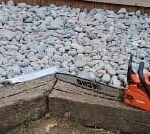As an Amazon Associate, this site earns commissions from qualifying purchases. For more information click here.
If you have to choose between a chainsaw and a circular saw, what is the best choice? This is a common question that pops up, and you have probably gotten different answers. To help you make the right decision, this post will point out the differences between the two and where they work best. This way you can make an informed choice.
Chainsaws are used to cut trees, tree limbs and logs. Circular saws are designed for lumber and wood boards that have been pre-cut to size, such as plywood. Chainsaw cuts are large and rough, while circular saws produce smaller, cleaner cuts.
Chainsaw vs. Circular Saw
Both of these are saws, but the function and design are different. It does not make one superior over the other, just that a chainsaw is more suited for certain tasks better than a circular saw and vice versa. They both have pros and cons as well. Below you will see the major points of comparison.
| Chainsaw | Circular Saw | |
| What it is for | Trees, logs, branches of various sizes | Lumber, boards, wooden planks |
| Cutting speed | Slow | Fast |
| Cutting capacity | Large | Small |
| Cutting power | High | Less powerful |
| Finished cut | Rough | Fine |
| Accuracy | Low | High |
| Power source | Gas, electric, battery | Electric |
| Maintenance need | High | Low |
| Cost of purchase | Lower | Higher |
| Portability | Heavy | Light |
The table is meant to give you an overview of the major differences between each one. For a detailed comparison, there is additional information provided. We will focus on the differences in design, functionality, application and maintenance.
In terms of what to actually use, when it comes to chainsaws we prefer the Proyama 62CC 2-Cycle Gas Powered Chainsaw. it cuts cleans, is efficient and its anti-vibration system works as advertised.
Now if you prefer a circular saw, we highly recommend the 15A Skil as it delivers a lot of power and with lots of good safety features too.
Chainsaw vs. Circular Saw: Design
Chainsaw. A chainsaw has a 16-20 inch bar, and around it is a moving chain. The chain has sharp ends and serves as the blade. When you turn a chainsaw on, the chain rotates rapidly and is what is used for cutting.
Chainsaws come in two types: gas and electric. A gas chainsaw is usually powered by a 2-stroke engine and needs a mixture of oil and gas. These are the most powerful chainsaws available.
An electric chainsaw runs on an electric motor. There are two kinds of electric chainsaws, corded and cordless. A cordless chainsaw runs on a rechargeable battery. Once the battery is charged you can use the chainsaw.
Circular saw. As the name suggests, a circular saw consists of a circular blade that spins when activated. The blade is 7 1/2 inches in diameter and has a cutting depth of 2-3 inches. The blade is flat and the teeth are configured around it.
Circular saws run on electricity, either with a cord or via a battery. To use a battery powered circular saw, you have to charge the battery first. When fully charged, you can use the circular saw without a cord. This is also how cordless chainsaws work.
Chainsaw vs. Circular Saw: Cutting Power and Uses
Chainsaw. These cutting tools are used mainly to fell large trees. Their powerful blades can also cut thick branches, logs and cut fallen trees down to size. For rough and rapid cuts, chainsaws are ideal. It can be used on fallen or standing trees.
Smaller chainsaws can be used to cut small trees, branches and firewood. There are also specially made chainsaws for \ and lumber milling. These smaller chainsaws are either corded or cordless as gas powered models are for heavy duty tree cutting.
A powerful chainsaw can fell a large tree and cut huge logs with ease. When it comes to power tools, gas is needed for large scale work and electricity or batteries for smaller tasks. This is true for chainsaws.
Circular saw. A circular saw is used to make clear, precision cuts on lumber and other types of wood that have been cut to a specific size. A circular saw can be used to cut plywood, planks or similar material to further refine the shape.
Because its blade is smaller, a circular saw cannot bring down a tree or cut thick logs. But it works great on thin wood planks. With a circular saw you can make fast, precise cuts, something a chainsaw cannot do.
Chainsaw vs. Circular Saw: Cutting Finish and Speed
Chainsaw. This saw makes large cuts, but they are rough. If you need to cut a tree down or turn that large into smaller chunks, a chainsaw will do. But do not expect a smooth finish. The blade will cut the wood through but it will look and feel rough.
Chainsaws are not fast either. But this is not surprising considering the size of the material it is cutting. If you are cutting down a tree, you want it done slowly and carefully. Corded and portable chainsaws cut small branches and wood faster, but it is not as refined as a circular saw.
Circular saw. The smaller blade allows the tool to make faster and cleaner cuts. It is for this reason they are widely used by carpenters and DIY enthusiasts. A circular saw is just the right size to cut wood planks to a specific dimensions.
You cannot use a circular saw chop a thick log into smaller pieces. For that you need a chainsaw. But after you are done, you can use a circular saw to better refine the material. This way the tools complement one another.

Chainsaw vs. Circular Saw: Maintenance
Chainsaw. Chainsaws are high maintenance tools. You have to refuel it every 30 days. If there is still gas left in the tank, you have to dispose of it. Old fuel turns into a thick sludge and can clog the engine. Another thing to remember is that you must not let chainsaws run out of gas, as it can be problematic.
You also have to lubricate regularly for optimum performance. The air filter has to be cleaned after every 10 hours of use. The spark plug, carburetor, fuel line, clutch cover and bar have to be cleaned regularly.
The chains need regular sharpening. You have to keep an eye out for missing teeth, broken rivets and cracks. Also the fuel tank could leak and needs attention. The other parts like the muffler, starter cord, chain brake etc. all need maintenance.
Circular saw. Very little maintenance is needed. It does not need lubrication and the blade rarely requires sharpening. About the only thing you have to do is make sure the cord has not frayed or worn out.
Advantages of a Chainsaw
- Powerful enough to cut large tree and logs. If you need raw power, circular saws cannot match a chainsaw.
- Chainsaws are cheaper.
- A chainsaw can cut trees and wood of varying sizes.
- There are lots of options available. If you want power, go with a gas chainsaw. If you want something lighter, electric and cordless models are available too.
Disadvantages of a Chainsaw
- Gas chainsaws need a lot of maintenance. You have to clean the machine regularly and replace the chai and filters 2-3 times a year.
- Additional expenses include the gas, oil, fuel stabilizer, carburetor cleaner and buying replacement parts.
- The chain has to be sharpened regularly.
Advantages of a Circular Saw
- Circular saws are low maintenance. Once you pay for it, no need to buy fuel or a cleaning solution. There is no need for lubricants or sharpening either.
- Circular saws are up to 30% faster than chainsaws and more precise. If you want fast, clean cuts, this tool is for you.
- Always available for use. Because the tool needs very little maintenance, it is always at your disposal. The same cannot be said for a chainsaw when it is undergoing maintenance.
- Increased productivity. If you work mostly with plywood, small wood planks and DIY projects, a circular saw is a handy tool. You get more work done in less time.
Disadvantages of a Circular Saw
- More expensive. This cutting tool costs more than a chainsaw.
- Limited cutting capacity. Its blade can only cut small pieces of wood. It cannot be used on trees.
- Needs a steady hand to produce the best results. It can generate excellent results but will require practice.

I love the outdoors and all the tools for maintaining gardens, yards and lawns. The only thing I am more passionate about is sharing what I know about garden and outdoor equipment.


